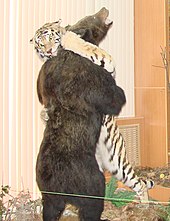Ussuri brown bear
[5] In middle Sakhalin in spring, brown bears feed on the previous year's red bilberry, ants, and marine carrion, and at the end of the season, they concentrate on the shoots and rhizomes of tall grasses.
[citation needed] In springtime in Sikhote Alin, they feed on acorns, Manchurian walnuts, and Korean nut pine seeds.
In times of scarcity, in addition to bilberries and nuts, they feed on larvae, wood-boring ants, and lily roots.
[4] In Hokkaido, the brown bears' diet includes small and large mammals, fish, birds, and insects such as ants.
Following a decrease of ungulate populations from 1944 to 1959, 32 cases of Siberian tigers attacking both Ussuri brown (Ursus arctos lasiotus) and Ussuri black bears (U. thibetanus ussuricus) were recorded in the Russian Far East, and hair of bears were found in several tiger scat samples.
In the same time period, four cases of brown bears killing female tigers and young cubs were reported, both in disputes over prey and in self-defense.
[17] There are reports of brown bears specifically targeting Amur leopards and tigers to abstract their prey.
[23] On Shiretoko Peninsula, especially in the area called "Banya", many females with cubs often approach fishermen and spend time near people.
Until the 13th century, bears inhabited the islands of Rebun and Rishiri, having crossed the La Pérouse Strait[25][failed verification] to reach them.
They were also present on Honshu during the last glacial period, but were possibly driven to extinction either by competing with Asian black bears[26] or by habitat loss due to climate change.
Illegal hunting and capture have become very serious contributing factors to the decline in bear numbers, as their body parts are of high economic value.
Of these, the small size and isolation of the western Ishikari subpopulation has warranted its listing as an endangered species in Japan's Red Data Book.
[33] The others from Hamkyo'ng Mountains are called GwanMoBong Ku'n Gom (GwanMo Peak big bear) and they are listed as Natural Monument No.330 of North Korea.
[33] The Ainu people worship the Ussuri brown bear, eating its flesh and drinking its blood as part of a religious festival known as Iomante.

